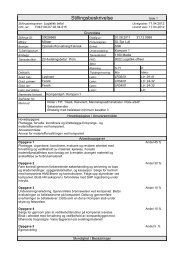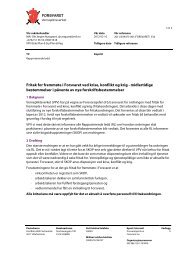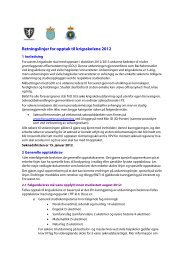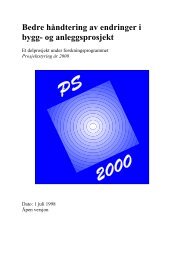Litteraturstudie - Tidligfasevurdering av prosjekter - Concept - NTNU
Litteraturstudie - Tidligfasevurdering av prosjekter - Concept - NTNU
Litteraturstudie - Tidligfasevurdering av prosjekter - Concept - NTNU
You also want an ePaper? Increase the reach of your titles
YUMPU automatically turns print PDFs into web optimized ePapers that Google loves.
CONCEPTFront-end Management of Major ProjectsSikring <strong>av</strong> store investerings<strong>prosjekter</strong>DOC TYPE: Journal article.SPECIAL FEATURE: Graphs Diagrams Equations ReferencesABSTRACT: A tool for automating software metrics collection and aclassification model that identifies complex procedures are presented. Amethodology using discriminant analysis consists of 4 steps: 1. collectingmetrics for a well-known software project, 2. selecting a set ofindependent metrics, 3. deriving decision rules and classificationfunctions, and 4. setting up norms and applying decision rules to newsoftware. Procedures are given for use of discriminant analysis todetermine: 1. the metrics that are good discriminators, 2. how well themetrics discriminate between groups, and 3. the decision rule forclassifying. The complexity analyzer consists of a screen formatter, acompiler front end, and modules to produce code metrics, an informationflow metric, and discriminant statistics. Results of a case study supportthe concept of complexity and its detectability by software metrics.However, one shortcoming is the classification of sample software into justsimple or complex.A Management-Oriented Approach to Systems DevelopmentKoudry, HerbertJournal of Systems Management.DOC TYPE: Journal article.ABSTRACT: Little importance is attached to the front end of the systemdevelopment cycle, but it is the fulcrum for the success or failure of asystems project. Two factors involved in the problem definition phase are:1. viewing this phase in narrow technical terms, which leads to assigninginadequate time to it, and 2. a lack of adequate methodology. A disciplineof system analysis, or systematics, is needed to replace the prevalent''top-down'' machine-oriented methodologies. The benefits of systematicsinclude: 1. systems designs that more specifically and accurately defineuser needs, 2. making the systems analyst a full professional, and 3. theevolution of a more meaningful academic structure for systems analysis. Theprobable attributes of a discipline of systematics include: 1. analyticaltechniques supporting a concept of an integrated design including bothinformation flow and operational activity, 2. techniques for producing asolution convertible to machine processing, and 3. documentationtechniques.Title: Benefits of a systematic approach for problem analysis onmanufacturing simulation modellingAuthor: Lung, A.W.M.Corporate Source: Kingston Univ, Surrey, UKConference Title: Proceedings of the 1998 International Conference onSimulationConference Location: York, UKSource: IEE Conference Publication.Abstract: A collaborative project with a consultancy company whichLitteraturstudium innen tidligfasevurderinger <strong>av</strong> <strong>prosjekter</strong> 81
















